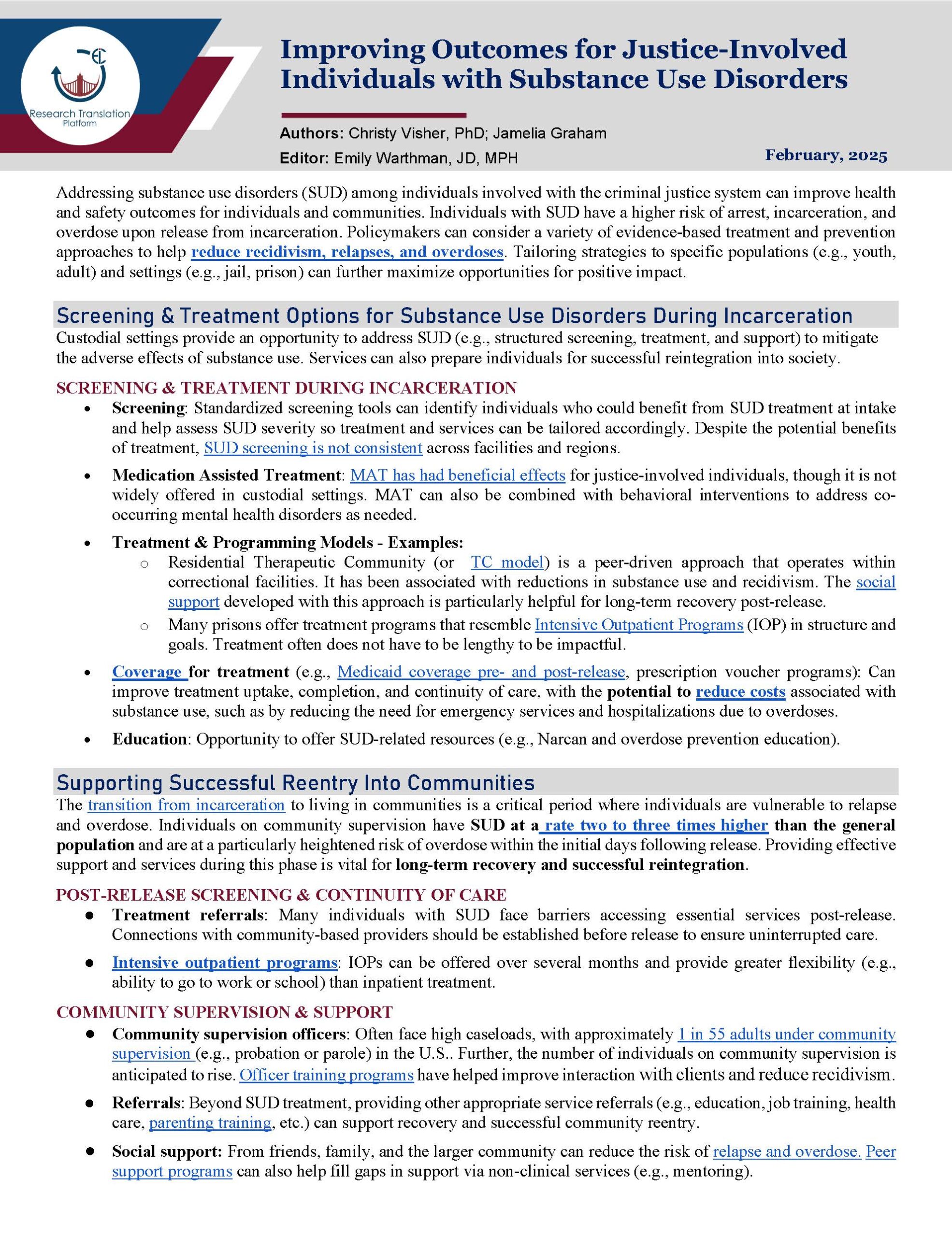
Addressing substance use disorders (SUD) among individuals involved with the criminal justice system can improve health and safety outcomes for individuals and communities. Individuals with SUD have a higher risk of arrest, incarceration, and overdose upon release from incarceration. Policymakers can consider a variety of evidence-based treatment and prevention approaches to help reduce recidivism, relapses, and overdoses. Tailoring strategies to specific populations (e.g., youth, adult) and settings (e.g., jail, prison) can further maximize opportunities for positive impact.
Screening & Treatment Options for Substance Use Disorders During Incarceration
Custodial settings provide an opportunity to address SUD (e.g., structured screening, treatment, and support) to mitigate the adverse effects of substance use. Services can also prepare individuals for successful reintegration into society.
SCREENING & TREATMENT DURING INCARCERATION
- Screening: Standardized screening tools can identify individuals who could benefit from SUD treatment at intake and help assess SUD severity so treatment and services can be tailored accordingly. Despite the potential benefits of treatment, SUD screening is not consistent across facilities and regions.
- Medication Assisted Treatment: MAT has had beneficial effects for justice-involved individuals, though it is not widely offered in custodial settings. MAT can also be combined with behavioral interventions to address co-occurring mental health disorders as needed.
- Treatment & Programming Models – Examples:
- Residential Therapeutic Community (or TC model) is a peer-driven approach that operates within correctional facilities. It has been associated with reductions in substance use and recidivism. The social support developed with this approach is particularly helpful for long-term recovery post-release.
- Many prisons offer treatment programs that resemble Intensive Outpatient Programs (IOP) in structure and goals. Treatment often does not have to be lengthy to be impactful.
- Coverage for treatment (e.g., Medicaid coverage pre- and post-release, prescription voucher programs): Can improve treatment uptake, completion, and continuity of care, with the potential to reduce costs associated with substance use, such as by reducing the need for emergency services and hospitalizations due to overdoses.
- Education: Opportunity to offer SUD-related resources (e.g., Narcan and overdose prevention education).
Supporting Successful Reentry Into Communities
The transition from incarceration to living in communities is a critical period where individuals are vulnerable to relapse and overdose. Individuals on community supervision have SUD at a rate two to three times higher than the general population and are at a particularly heightened risk of overdose within the initial days following release. Providing effective support and services during this phase is vital for long-term recovery and successful reintegration.
POST-RELEASE SCREENING & CONTINUITY OF CARE
- Treatment referrals: Many individuals with SUD face barriers accessing essential services post-release. Connections with community-based providers should be established before release to ensure uninterrupted care.
- Intensive outpatient programs: IOPs can be offered over several months and provide greater flexibility (e.g., ability to go to work or school) than inpatient treatment.
COMMUNITY SUPERVISION & SUPPORT
- Community supervision officers: Often face high caseloads, with approximately 1 in 55 adults under community supervision (e.g., probation or parole) in the U.S.. Further, the number of individuals on community supervision is anticipated to rise. Officer training programs have helped improve interaction with clients and reduce recidivism.
- Referrals: Beyond SUD treatment, providing other appropriate service referrals (e.g., education, job training, health care, parenting training, etc.) can support recovery and successful community reentry.
- Social support: From friends, family, and the larger community can reduce the risk of relapse and overdose. Peer support programs can also help fill gaps in support via non-clinical services (e.g., mentoring).
Policy Options Summary
Improving outcomes for justice-involved individuals with SUD can provide significant benefits for individuals, families, and communities. There are a variety of evidence-based strategies policymakers can consider that have been associated with positive outcomes, such as reductions in recidivism and overdoses. A combination of treatment, prevention, and harm reduction approaches can be leveraged to support this population, particularly during community reentry.
- Screen for SUD on intake and provide referrals as appropriate to treatment and related programming.
- Tailor to individual needs to maximize effectiveness (e.g., MAT, counseling, TC Model, IOPs, etc.).
- Address barriers to MAT, such as stigma, insufficient resources, and training needs, among others.
- Integrate effective, evidence-based practices into interventions – during incarceration and reentry.
- Enhance coordination between DOC & community treatment to improve continuity of care. Individualized reentry plans can address SUD treatment, housing, employment assistance, and connection to other key resources.
- Offer workforce training & development opportunities for community supervision officers and equip mental health and SUD professionals (e.g., training on telehealth and MAT prescribing, regulation flexibility, etc.) to address barriers to care (e.g., provider shortages and heavy caseloads).
- The peer support workforce can also be leveraged to bridge services and fill gaps in support. States can consider frameworks for certification, such as the National Model Standards.
- Encourage additional research to better understand specific programs’ effectiveness for justice-involved individuals with SUD. Though research can be difficult to conduct in custodial settings, further study in the following areas could be particularly beneficial:
- research designs that include longer follow-up to assess outcomes over time,
- improved measurement of treatment interventions and outcomes,
- studying the impact of timing on in-custody programming, and
- evaluating programs’ effectiveness on SUD relapse.
Select Resources
- Implementing Evidence-Based Strategies to Reduce Overdose Risk during Reentry (primer for reentry professionals)
- Improving Responses to People who Have Co-occurring Mental Illnesses & Substance Use Disorders in Jails
- Medicaid & Corrections (curated resources hosted by the National Reentry Resource Center)
- Results from the 2023 National Survey on Drug Use & Health (NSDUH) (Key Substance Use & Mental Health Indicators in the United States)
- Understanding Overdose Risk for People Reentering the Community (An Informational Guide for Families)
The Research-to-Policy Collaboration (RPC) works to bring together research professionals and public officials to support evidence-based policy. Please visit their website to learn more.
Key Information
RPC Website
Research-to-Policy Collaboration
Publication DateFebruary 17, 2025
Topic Area(s)Substance Use and Misuse
Resource TypeWritten Briefs
Share This Page
Addressing substance use disorders (SUD) among individuals involved with the criminal justice system can improve health and safety outcomes for individuals and communities. Individuals with SUD have a higher risk of arrest, incarceration, and overdose upon release from incarceration. Policymakers can consider a variety of evidence-based treatment and prevention approaches to help reduce recidivism, relapses, and overdoses. Tailoring strategies to specific populations (e.g., youth, adult) and settings (e.g., jail, prison) can further maximize opportunities for positive impact.
Screening & Treatment Options for Substance Use Disorders During Incarceration
Custodial settings provide an opportunity to address SUD (e.g., structured screening, treatment, and support) to mitigate the adverse effects of substance use. Services can also prepare individuals for successful reintegration into society.
SCREENING & TREATMENT DURING INCARCERATION
- Screening: Standardized screening tools can identify individuals who could benefit from SUD treatment at intake and help assess SUD severity so treatment and services can be tailored accordingly. Despite the potential benefits of treatment, SUD screening is not consistent across facilities and regions.
- Medication Assisted Treatment: MAT has had beneficial effects for justice-involved individuals, though it is not widely offered in custodial settings. MAT can also be combined with behavioral interventions to address co-occurring mental health disorders as needed.
- Treatment & Programming Models – Examples:
- Residential Therapeutic Community (or TC model) is a peer-driven approach that operates within correctional facilities. It has been associated with reductions in substance use and recidivism. The social support developed with this approach is particularly helpful for long-term recovery post-release.
- Many prisons offer treatment programs that resemble Intensive Outpatient Programs (IOP) in structure and goals. Treatment often does not have to be lengthy to be impactful.
- Coverage for treatment (e.g., Medicaid coverage pre- and post-release, prescription voucher programs): Can improve treatment uptake, completion, and continuity of care, with the potential to reduce costs associated with substance use, such as by reducing the need for emergency services and hospitalizations due to overdoses.
- Education: Opportunity to offer SUD-related resources (e.g., Narcan and overdose prevention education).
Supporting Successful Reentry Into Communities
The transition from incarceration to living in communities is a critical period where individuals are vulnerable to relapse and overdose. Individuals on community supervision have SUD at a rate two to three times higher than the general population and are at a particularly heightened risk of overdose within the initial days following release. Providing effective support and services during this phase is vital for long-term recovery and successful reintegration.
POST-RELEASE SCREENING & CONTINUITY OF CARE
- Treatment referrals: Many individuals with SUD face barriers accessing essential services post-release. Connections with community-based providers should be established before release to ensure uninterrupted care.
- Intensive outpatient programs: IOPs can be offered over several months and provide greater flexibility (e.g., ability to go to work or school) than inpatient treatment.
COMMUNITY SUPERVISION & SUPPORT
- Community supervision officers: Often face high caseloads, with approximately 1 in 55 adults under community supervision (e.g., probation or parole) in the U.S.. Further, the number of individuals on community supervision is anticipated to rise. Officer training programs have helped improve interaction with clients and reduce recidivism.
- Referrals: Beyond SUD treatment, providing other appropriate service referrals (e.g., education, job training, health care, parenting training, etc.) can support recovery and successful community reentry.
- Social support: From friends, family, and the larger community can reduce the risk of relapse and overdose. Peer support programs can also help fill gaps in support via non-clinical services (e.g., mentoring).
Policy Options Summary
Improving outcomes for justice-involved individuals with SUD can provide significant benefits for individuals, families, and communities. There are a variety of evidence-based strategies policymakers can consider that have been associated with positive outcomes, such as reductions in recidivism and overdoses. A combination of treatment, prevention, and harm reduction approaches can be leveraged to support this population, particularly during community reentry.
- Screen for SUD on intake and provide referrals as appropriate to treatment and related programming.
- Tailor to individual needs to maximize effectiveness (e.g., MAT, counseling, TC Model, IOPs, etc.).
- Address barriers to MAT, such as stigma, insufficient resources, and training needs, among others.
- Integrate effective, evidence-based practices into interventions – during incarceration and reentry.
- Enhance coordination between DOC & community treatment to improve continuity of care. Individualized reentry plans can address SUD treatment, housing, employment assistance, and connection to other key resources.
- Offer workforce training & development opportunities for community supervision officers and equip mental health and SUD professionals (e.g., training on telehealth and MAT prescribing, regulation flexibility, etc.) to address barriers to care (e.g., provider shortages and heavy caseloads).
- The peer support workforce can also be leveraged to bridge services and fill gaps in support. States can consider frameworks for certification, such as the National Model Standards.
- Encourage additional research to better understand specific programs’ effectiveness for justice-involved individuals with SUD. Though research can be difficult to conduct in custodial settings, further study in the following areas could be particularly beneficial:
- research designs that include longer follow-up to assess outcomes over time,
- improved measurement of treatment interventions and outcomes,
- studying the impact of timing on in-custody programming, and
- evaluating programs’ effectiveness on SUD relapse.
Select Resources
- Implementing Evidence-Based Strategies to Reduce Overdose Risk during Reentry (primer for reentry professionals)
- Improving Responses to People who Have Co-occurring Mental Illnesses & Substance Use Disorders in Jails
- Medicaid & Corrections (curated resources hosted by the National Reentry Resource Center)
- Results from the 2023 National Survey on Drug Use & Health (NSDUH) (Key Substance Use & Mental Health Indicators in the United States)
- Understanding Overdose Risk for People Reentering the Community (An Informational Guide for Families)
The Research-to-Policy Collaboration (RPC) works to bring together research professionals and public officials to support evidence-based policy. Please visit their website to learn more.

Key Information
RPC Website
Research-to-Policy Collaboration
Publication DateFebruary 17, 2025
Topic Area(s)Substance Use and Misuse
Resource TypeWritten Briefs
Share This Page
LET’S STAY IN TOUCH
Join the Evidence-to-Impact Mailing List
Keep up to date with the latest resources, events, and news from the EIC.




